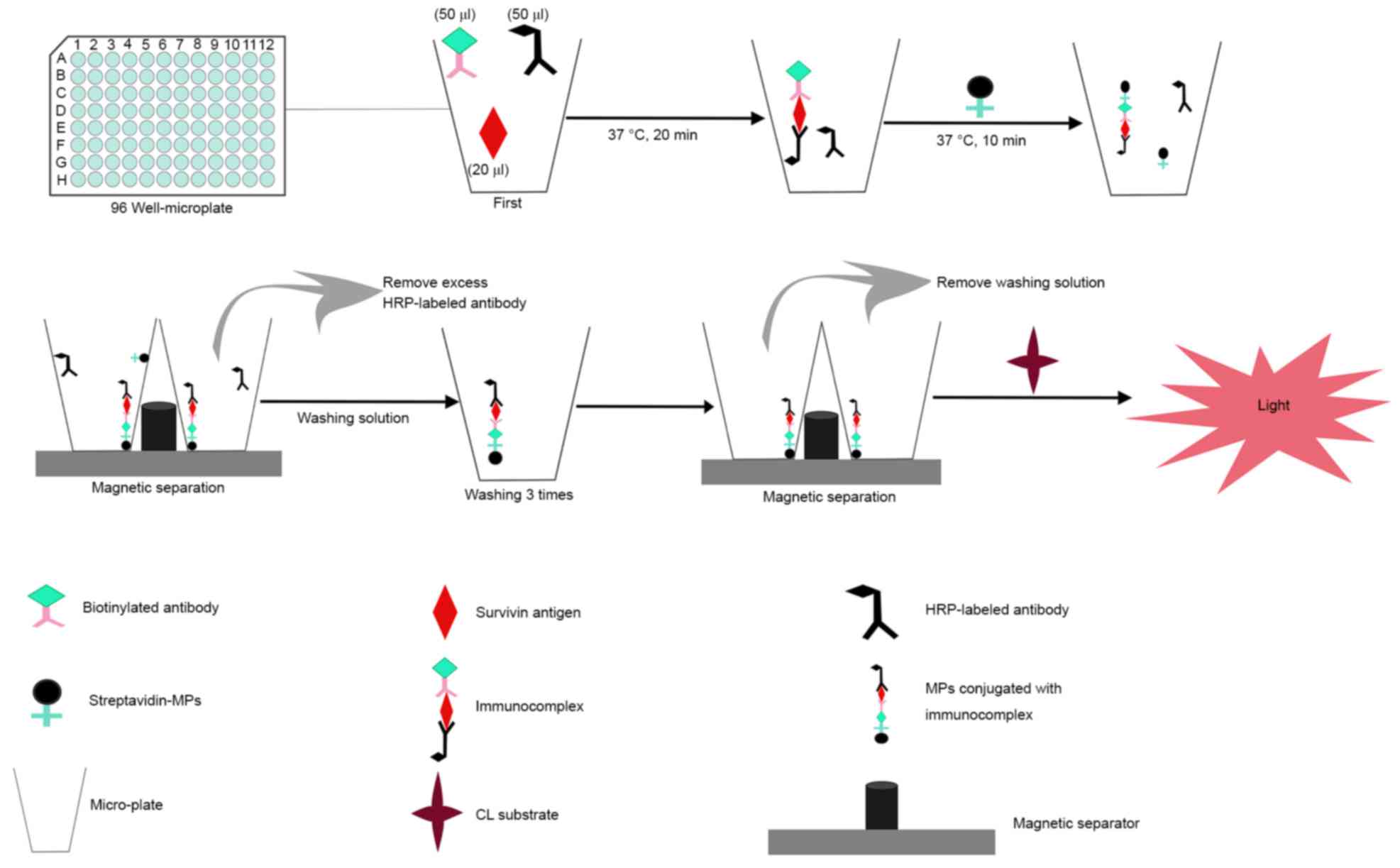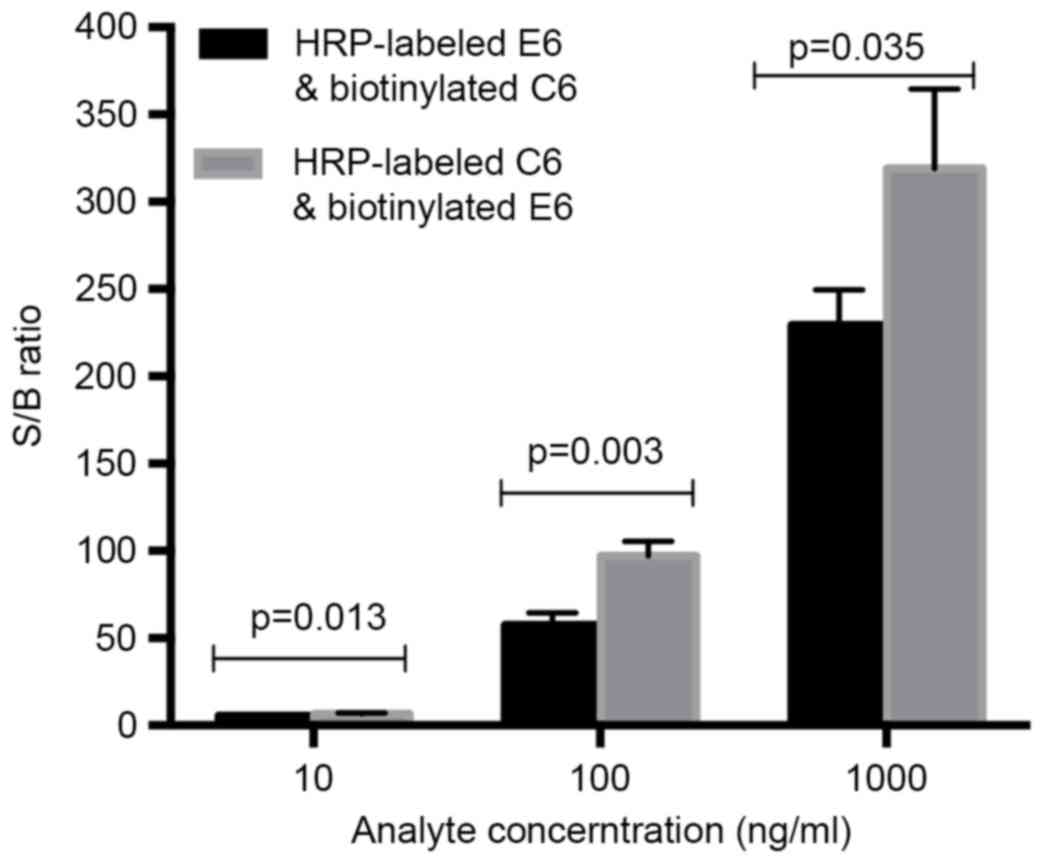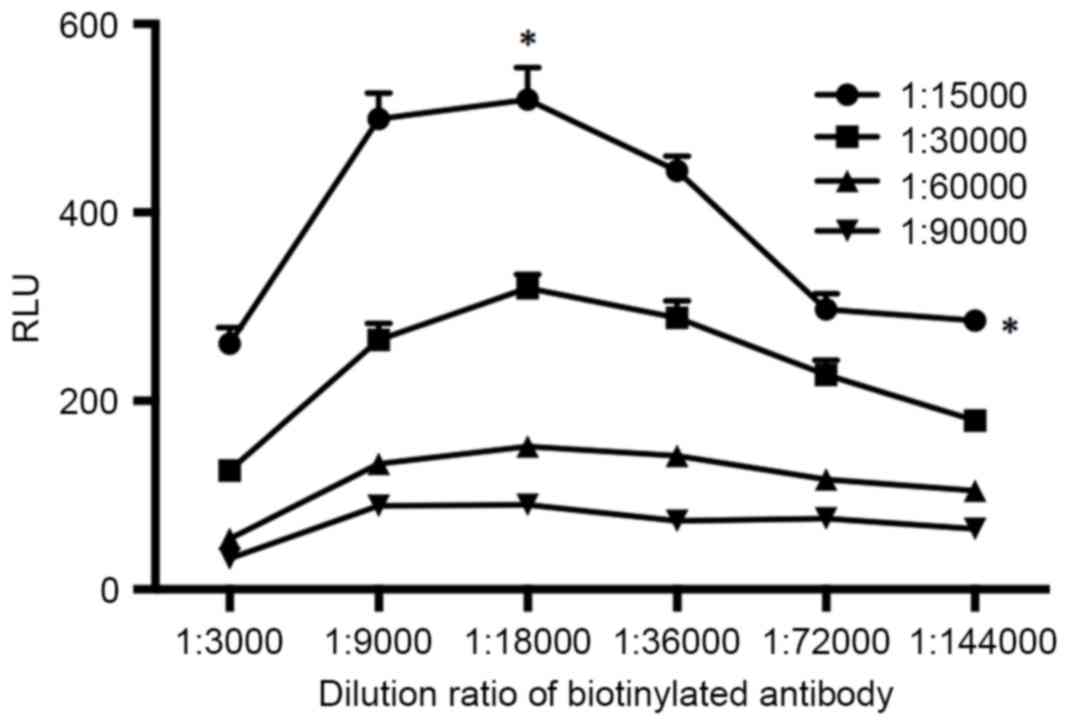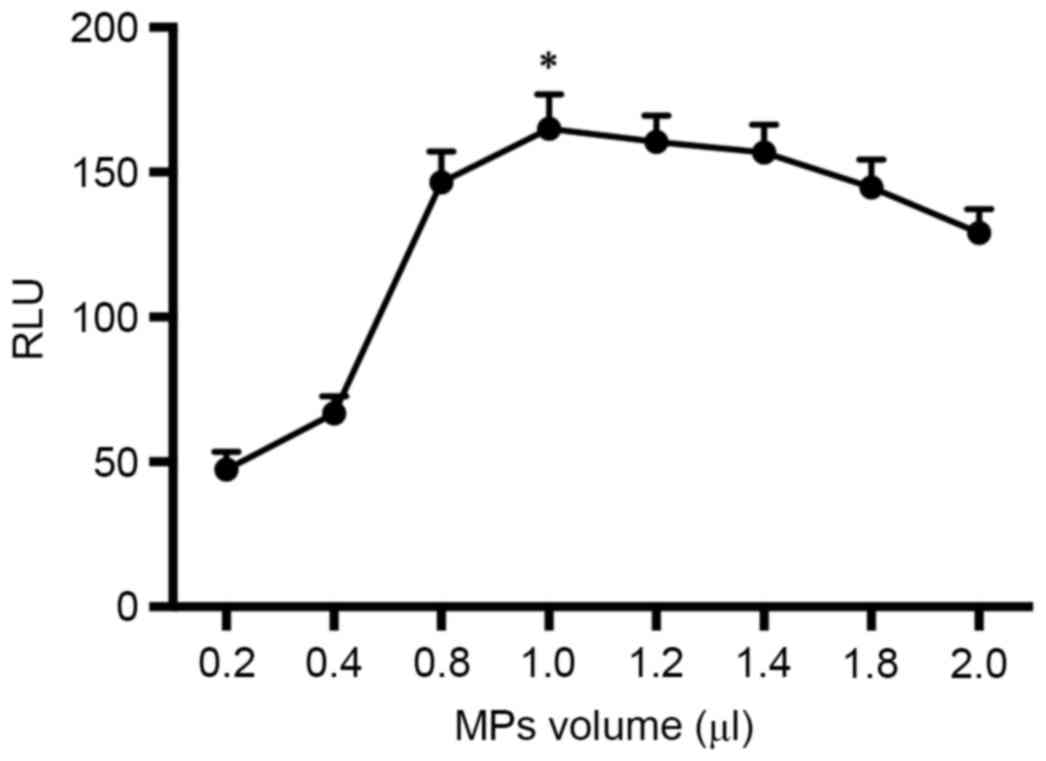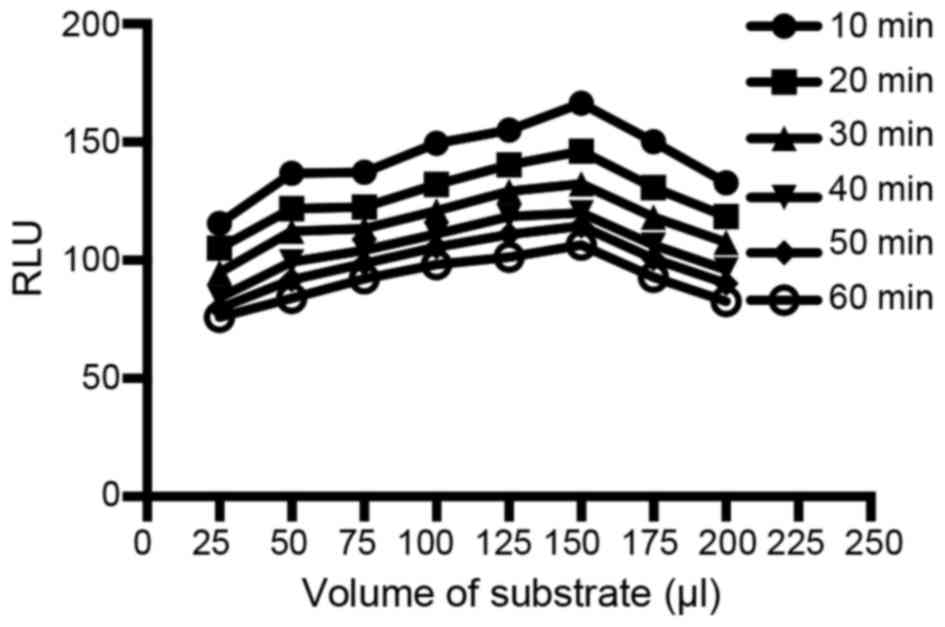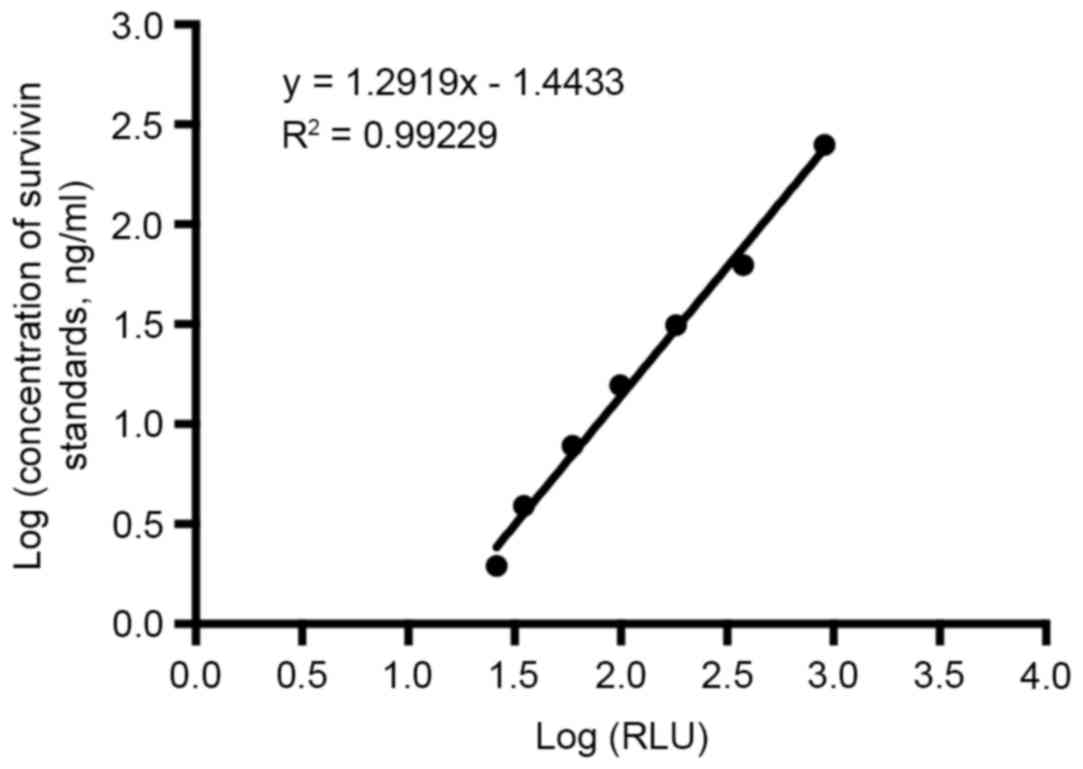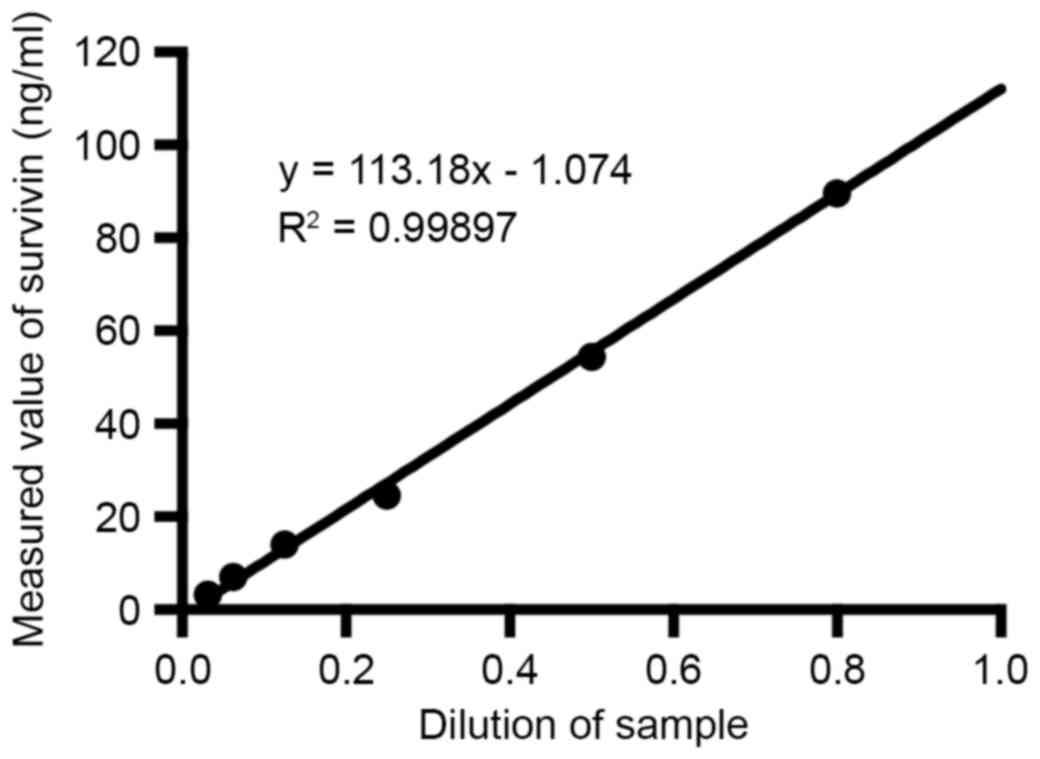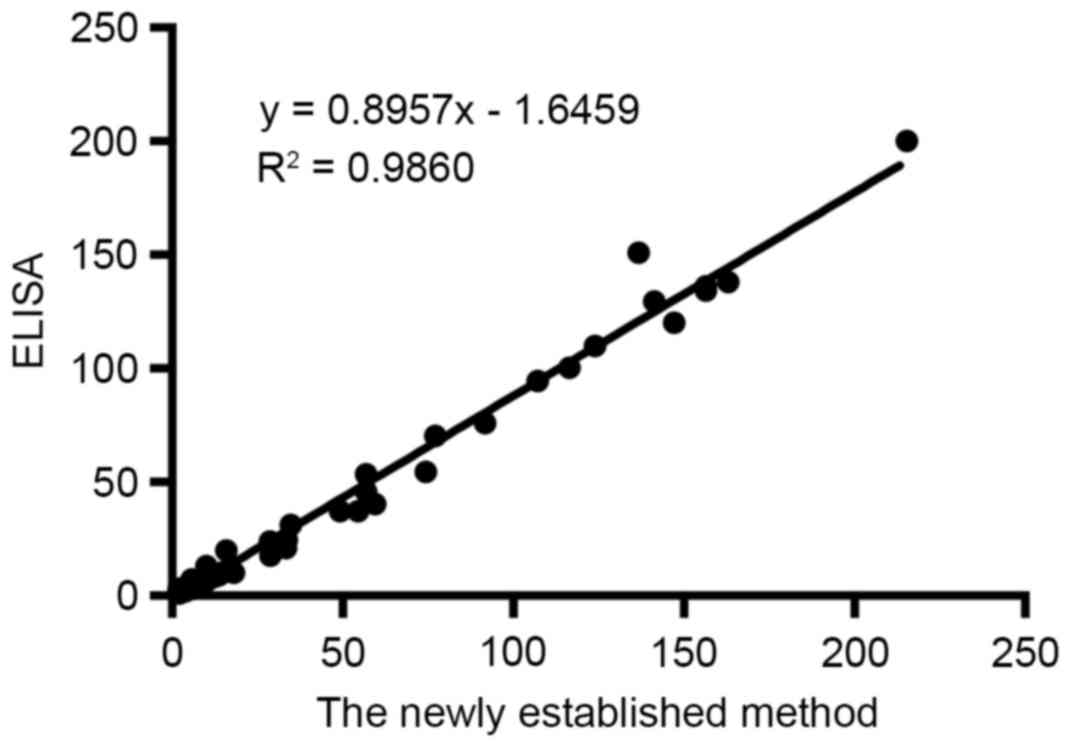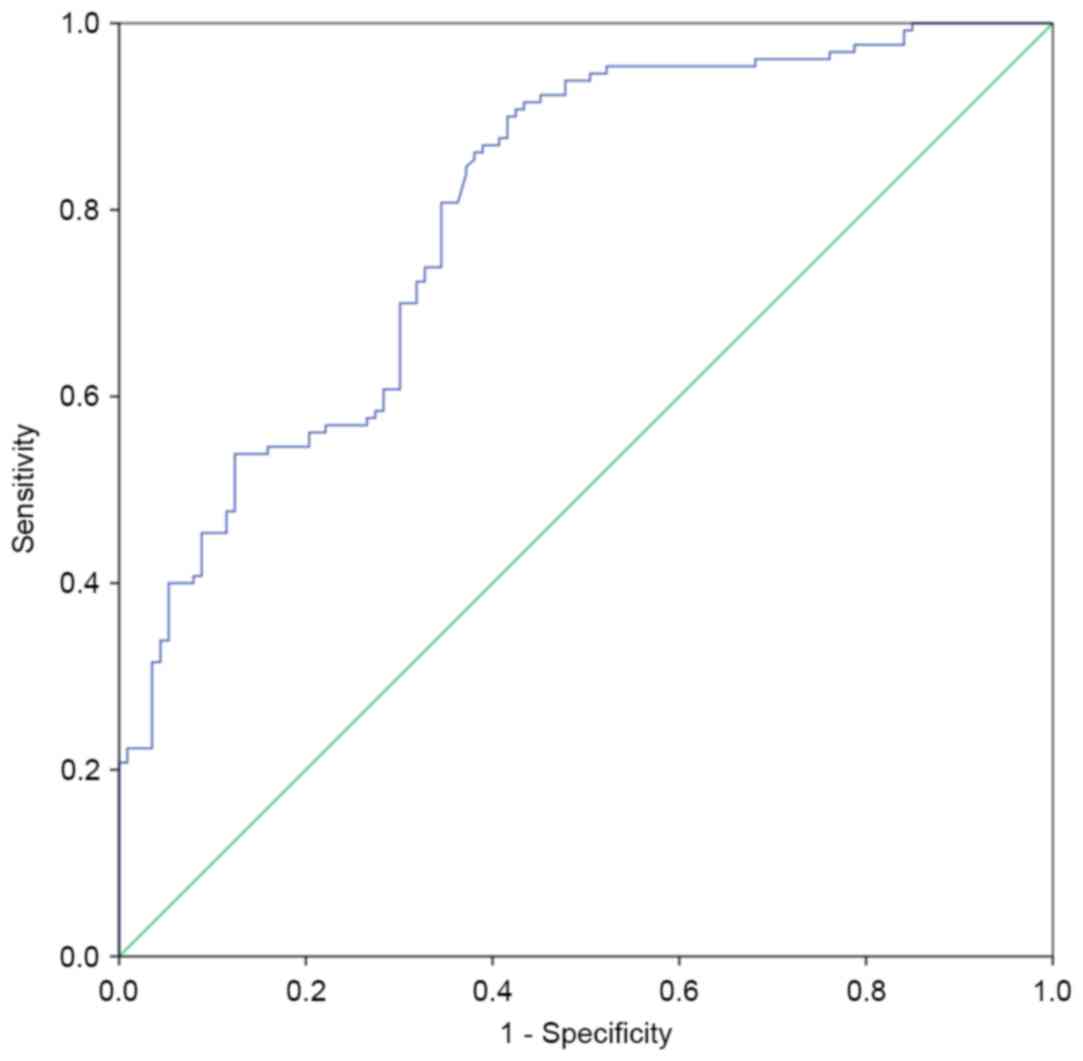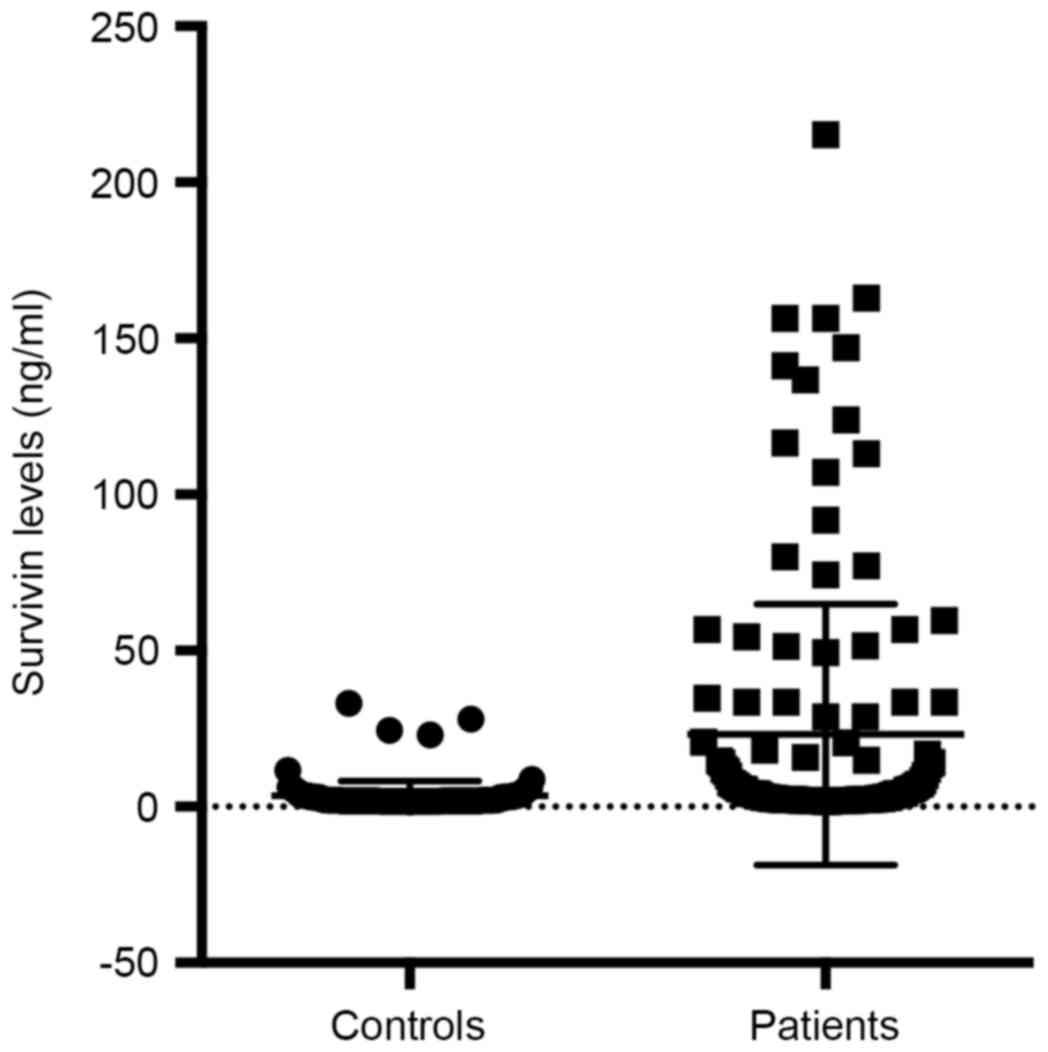|
1
|
Youssef RF and Lotan Y: Predictors of
outcome of non-muscle-invasive and muscle-invasive bladder cancer.
ScientificWorldJournal. 11:369–381. 2011. View Article : Google Scholar : PubMed/NCBI
|
|
2
|
Babjuk M, Böhle A, Burger M, Capoun O,
Cohen D, Compérat EM, Hernández V, Kaasinen E, Palou J, Rouprêt M,
et al: EAU guidelines on non-muscle-invasive urothelial carcinoma
of the bladder: Update 2016. Eur Urol. 71:447–461. 2017. View Article : Google Scholar : PubMed/NCBI
|
|
3
|
Lokeshwar VB, Habuchi T, Grossman HB,
Murphy WM, Hautmann SH, Hemstreet GP III, Bono AV, Getzenberg RH,
Goebell P, Schmitz-Dräger BJ, et al: Bladder tumor markers beyond
cytology: International consensus panel on bladder tumor markers.
Urology. 66:(6 Suppl 1). S35–S63. 2005. View Article : Google Scholar
|
|
4
|
Frantzi M, Latosinska A, Flühe L, Hupe MC,
Critselis E, Kramer MW, Merseburger AS, Mischak H and Vlahou A:
Developing proteomic biomarkers for bladder cancer: Towards
clinical application. Nat Rev Urol. 12:317–330. 2015. View Article : Google Scholar : PubMed/NCBI
|
|
5
|
Gogalic S, Sauer U, Doppler S and
Preininger C: Bladder cancer biomarker array to detect aberrant
levels of proteins in urine. Analyst. 140:724–735. 2015. View Article : Google Scholar : PubMed/NCBI
|
|
6
|
Kamat AM, Hegarty PK, Gee JR, Clark PE,
Svatek RS, Hegarty N, Shariat SF, Xylinas E, Schmitz-Dräger BJ,
Lotan Y, et al: ICUD-EAU International consultation on bladder
cancer 2012: Screening, diagnosis, and molecular markers. Eur Urol.
63:4–15. 2013. View Article : Google Scholar : PubMed/NCBI
|
|
7
|
Nisman B, Yutkin V, Peretz T, Shapiro A,
Barak V and Pode D: The follow-up of patients with
non-muscle-invasive bladder cancer by urine cytology, abdominal
ultrasound and urine CYFRA 21-1: A pilot study. Anticancer Res.
29:4281–4285. 2009.PubMed/NCBI
|
|
8
|
Jäger T, Tschirdewahn S, Vom Dorp F,
Piechotta G, Rübben H and Szarvas T: Siliconchiptechnology-based
MMP-7 analysis in urine: An option for preoperative identification
of lymph node metastasis in bladder cancer. Urologe A. 52:853–858.
2013. View Article : Google Scholar : PubMed/NCBI
|
|
9
|
Altieri DC: Survivin in apoptosis control
and cell cycle regulation in cancer. Prog Cell Cycle Res.
5:447–452. 2003.PubMed/NCBI
|
|
10
|
Uren AG, Wong L, Pakusch M, Fowler KJ,
Burrows FJ, Vaux DL and Choo KH: Survivin and the inner centromere
protein INCENP show similar cell-cycle localization and gene
knockout phenotype. Curr Biol. 10:1319–1328. 2000. View Article : Google Scholar : PubMed/NCBI
|
|
11
|
Giodini A, Kallio MJ, Wall NR, Gorbsky GJ,
Tognin S, Marchisio PC, Symons M and Altieri DC: Regulation of
microtubule stability and mitotic progression by survivin. Cancer
Res. 62:2462–2467. 2002.PubMed/NCBI
|
|
12
|
Zaffaroni N, Pennati M and Daidone MG:
Survivin as a target for new anticancer interventions. J Cell Mol
Med. 9:360–372. 2005. View Article : Google Scholar : PubMed/NCBI
|
|
13
|
Spaulding B, Pan D, Ghadersohi A, Nielsen
G, Jensen S, Gellert F, Ling X, Zhang M, Black A and Li F:
Characterization of the 12C4 survivin monoclonal antibody and
insight into the expression of survivin in human adult tissues.
Histopathology. 49:622–633. 2006. View Article : Google Scholar : PubMed/NCBI
|
|
14
|
Muschol-Steinmetz C, Friemel A, Kreis NN,
Reinhard J, Yuan J and Louwen F: Function of survivin in
trophoblastic cells of the placenta. PLoS One. 8:e733372013.
View Article : Google Scholar : PubMed/NCBI
|
|
15
|
Weikert S, Christoph F, Schrader M, Krause
H, Miller K and Müller M: Quantitative analysis of survivin mRNA
expression in urine and tumor tissue of bladder cancer patients and
its potential relevance for disease detection and prognosis. Int J
Cancer. 116:100–104. 2005. View Article : Google Scholar : PubMed/NCBI
|
|
16
|
Karam JA, Lotan Y, Ashfaq R, Sagalowsky AI
and Shariat SF: Survivin expression in patients with
non-muscle-invasive urothelial cell carcinoma of the bladder.
Urology. 70:482–486. 2007. View Article : Google Scholar : PubMed/NCBI
|
|
17
|
Margulis V, Lotan Y and Shariat SF:
Survivin: A promising biomarker for detection and prognosis of
bladder cancer. World J Urol. 26:59–65. 2008. View Article : Google Scholar : PubMed/NCBI
|
|
18
|
Li X, Wang Y, Xu J and Zhang Q: Sandwich
ELISA for detecting urinary survivin in bladder cancer. Chin J
Cancer Res. 25:375–381. 2013.PubMed/NCBI
|
|
19
|
Srivastava AK, Singh PK, Srivastava K,
Singh D, Dalela D, Rath SK, Goel MM and Bhatt Brahma ML: Diagnostic
role of survivin in urinary bladder cancer. Asian Pac J Cancer
Prev. 14:81–85. 2013. View Article : Google Scholar : PubMed/NCBI
|
|
20
|
Schneider C, Schöler HF and Schneider RJ:
Direct sub-ppt detection of the endocrine disruptor
ethinylestradiol in water with a chemiluminescence enzyme-linked
immunosorbent assay. Analyt Chim Acta. 551:92–97. 2005. View Article : Google Scholar
|
|
21
|
Gundersen SG, Haagensen I, Jonassen TO,
Figenschau KJ, de Jonge N and Deelder AM: Magnetic bead antigen
capture enzyme-linked immunoassay in microtitre trays for rapid
detection of schistosomal circulating anodic antigen. J Immunol
Methods. 148:1–8. 1992. View Article : Google Scholar : PubMed/NCBI
|
|
22
|
Chen D, Xu J and Zhang Q: Detection of
survivin expression in bladder cancer and renal cell carcinoma with
its specific monoclonal antibodies. Oncology Reports In Press.
|
|
23
|
Wang Y, Zhang QY and Wang YM: Cloning of
survivin gene and preparation its monoclonal antibodies as well as
checking survivin expression in liver carcinoma cells. Chinese
Journal of Laboratory Medicine. 2006.
|
|
24
|
Li Z, Zhang Q, Zhao L, Li Z, Hu G, Lin J
and Wang S: Micro-plate magnetic chemiluminescence immunoassay and
its applications in carcinoembryonic antigen analysis. Sci China
Chem. 53:812–819. 2010. View Article : Google Scholar
|
|
25
|
Herman MP, Svatek RS, Lotan Y, Karakiewizc
PI and Shariat SF: Urine-based biomarkers for the early detection
and surveillance of non-muscle invasive bladder cancer. Minerva
Urol Nefrol. 60:217–235. 2008.PubMed/NCBI
|
|
26
|
Budman LI, Kassouf W and Steinberg JR:
Biomarkers for detection and surveillance of bladder cancer. Can
Urol Assoc J. 2:212–221. 2008. View
Article : Google Scholar : PubMed/NCBI
|
|
27
|
Domnanich P, Sauer U, Pultar J and
Preininger C: Protein microarray for the analysis of human melanoma
biomarkers. Sensors Actuators B Chem. 139:2–8. 2009. View Article : Google Scholar
|
|
28
|
Li F and Ling X: Survivin study: An update
of ‘what is the next wave’? J Cell Physiol. 208:476–486. 2006.
View Article : Google Scholar : PubMed/NCBI
|
|
29
|
Eissa S, Shabayek MI, Ismail MF, El-Allawy
RM and Hamdy MA: Diagnostic evaluation of apoptosis inhibitory gene
and tissue inhibitor matrix metalloproteinase-2 in patients with
bladder cancer. IUBMB Life. 62:394–399. 2010.PubMed/NCBI
|
|
30
|
Qin C, Cao Q, Li P, Ju X, Wang M, Chen J,
Wu Y, Meng X, Zhu J, Zhang Z, et al: Functional promoter −31G>C
variant in survivin gene is associated with risk and progression of
renal cell cancer in a Chinese population. PLoS One. 7:e288292012.
View Article : Google Scholar : PubMed/NCBI
|
|
31
|
Jeon C, Kim M, Kwak C, Kim HH and Ku JH:
Prognostic role of survivin in bladder cancer: A systematic review
and meta-analysis. PLoS One. 8:e767192013. View Article : Google Scholar : PubMed/NCBI
|
|
32
|
Shariat SF, Casella R, Khoddami SM,
Hernandez G, Sulser T, Gasser TC and Lerner SP: Urine detection of
survivin is a sensitive marker for the noninvasive diagnosis of
bladder cancer. J Urol. 171:626–630. 2004. View Article : Google Scholar : PubMed/NCBI
|
|
33
|
Kenney DM, Geschwindt RD, Kary MR, Linic
JM, Sardesai NY and Li ZQ: Detection of newly diagnosed bladder
cancer, bladder cancer recurrence and bladder cancer in patients
with hematuria using quantitative rt-PCR of urinary survivin.
Tumour Biol. 28:57–62. 2007. View Article : Google Scholar : PubMed/NCBI
|
|
34
|
Moussa O, Abol-Enein H, Bissada NK, Keane
T, Ghoneim MA and Watson DK: Evaluation of survivin reverse
transcriptase-polymerase chain reaction for noninvasive detection
of bladder cancer. J Urol. 175:2312–2316. 2006. View Article : Google Scholar : PubMed/NCBI
|
|
35
|
Abd El-Hakim TF, El-Shafie MK, Abdou AG,
Azmy RM, El-Naidany SS and El-Din Badr MO: Value of urinary
survivin as a diagnostic marker in bladder cancer. Anal Quant
Cytopathol Histpathol. 36:121–127. 2014.PubMed/NCBI
|
|
36
|
Zhao L, Lin JM, Li Z and Ying X:
Development of a highly sensitive, second antibody format
chemiluminescence enzyme immunoassay for the determination of
17β-estradiol in wastewater. Anal Chim Acta. 558:290–295. 2006.
View Article : Google Scholar
|
|
37
|
Cudjoe KS, Hagtvedt T and Dainty R:
Immunomagnetic separation of Salmonella from foods and their
detection using immunomagnetic particle (IMP)-ELISA. Int J Food
Microbiol. 27:11–25. 1995. View Article : Google Scholar : PubMed/NCBI
|
|
38
|
Yu H, Ahmed H and Vasta GR: Development of
a magnetic microplate chemifluorimmunoassay for rapid detection of
bacteria and toxin in blood. Anal Biochem. 261:1–7. 1998.
View Article : Google Scholar : PubMed/NCBI
|
|
39
|
Zhang Q, Wang X, Li Z and Lin JM:
Evaluation of alpha-fetoprotein (AFP) in human serum by
chemiluminescence enzyme immunoassay with magnetic particles and
coated tubes as solid phases. Anal Chim Acta. 631:212–217. 2009.
View Article : Google Scholar : PubMed/NCBI
|
|
40
|
Wang H, Xi X, Kong X, Huang G and Ge G:
The expression and significance of survivin mRNA in urinary bladder
carcinomas. J Cancer Res Clin Oncol. 130:487–490. 2004. View Article : Google Scholar : PubMed/NCBI
|
|
41
|
Wu J, Chen YD and Gu W: Urinary proteomics
as a novel tool for biomarker discovery in kidney diseases. J
Zhejiang Univ Sci B. 11:227–237. 2010. View Article : Google Scholar : PubMed/NCBI
|
|
42
|
Fichorova RN, Richardson-Harman N, Alfano
M, Belec L, Carbonneil C, Chen S, Cosentino L, Curtis K, Dezzutti
CS, Donoval B, et al: Biological and technical variables affecting
immunoassay recovery of cytokines from human serum and simulated
vaginal fluid: A multicenter study. Anal Chem. 80:4741–4751. 2008.
View Article : Google Scholar : PubMed/NCBI
|
|
43
|
Johnen G, Gawrych K, Bontrup H, Pesch B,
Taeger D, Banek S, Kluckert M, Wellhäußer H, Eberle F, Nasterlack
M, et al: Performance of survivin mRNA as a biomarker for bladder
cancer in the prospective study UroScreen. PLoS One. 7:e353632012.
View Article : Google Scholar : PubMed/NCBI
|
|
44
|
Horstmann M, Bontrup H, Hennenlotter J,
Taeger D, Weber A, Pesch B, Feil G, Patschan O, Johnen G, Stenzl A
and Brüning T: Clinical experience with survivin as a biomarker for
urothelial bladder cancer. World J Urol. 28:399–404. 2010.
View Article : Google Scholar : PubMed/NCBI
|
|
45
|
Sun YW, Xuan Q, Shu QA, Wu SS, Chen H,
Xiao J, Xiang P, Zhu YP, Wang FL and Zhao ST: Correlation of tumor
relapse and elevated expression of survivin and vascular
endothelial growth factor in superficial bladder transitional cell
carcinoma. Genet Mol Res. 12:1045–1053. 2013. View Article : Google Scholar : PubMed/NCBI
|
|
46
|
Karam JA, Lotan Y, Karakiewicz PI, Ashfaq
R, Sagalowsky AI, Roehrborn CG and Shariat SF: Use of combined
apoptosis biomarkers for prediction of bladder cancer recurrence
and mortality after radical cystectomy. Lancet Oncol. 8:128–136.
2007. View Article : Google Scholar : PubMed/NCBI
|
|
47
|
Als AB, Dyrskjøt L, von der Maase H, Koed
K, Mansilla F, Toldbod HE, Jensen JL, Ulhøi BP, Sengeløv L, Jensen
KM and Orntoft TF: Emmprin and survivin predict response and
survival following cisplatin-containing chemotherapy in patients
with advanced bladder cancer. Clin Cancer Res. 13:4407–4414. 2007.
View Article : Google Scholar : PubMed/NCBI
|
|
48
|
Adachi J, Kumar C, Zhang Y, Olsen JV and
Mann M: The human urinary proteome contains more than 1500
proteins, including a large proportion of membrane proteins. Genome
Biol. 7:R802006. View Article : Google Scholar : PubMed/NCBI
|



